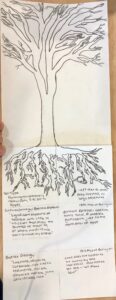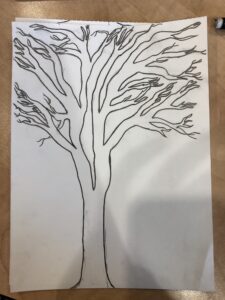I visited my phenology site for the first time with snow and the for the last time this semester this week. Although there was not a crazy amount of snow, there was enough to transform the look of my phenology site. The light dusting of snow, the cedar trees, and the wind from the lake combined to make my visit feel like I was in a snow globe. In addition to more classic phenological changes that I aim to observe when I visit, such as the leaves (or lack thereof) on the trees, I was keeping an eye out for possible animal tracks or signs and for remnants of past human history and current activity on the site.
I’m not sure if my eye is trained well enough yet to recognize most animal tracks, and so I have to say that I did not see any. But, that does not mean that they wasn’t an animal presence at my phonology site. I’m looking forward to NR2 and learning more about tracking wildlife, and hopefully bringing that back into a phenology setting.
I found myself looking into the human history of Rock Point, and specifically my site more thoroughly. While at my phenology site I was looking for how the land might have been affected in the past, especially knowing that there was a time in Vermont’s history that many trees were cut down. Knowing the signs from past labs, such as Ricker Mountain, I was looking for trees of the same age and non-undulating land. However, that is not what my phonology site looks like. There is a healthy understory and the over-story has a few different kinds of main trees and they didn’t appear to be all the same age. I wondered if it was possible that my phonology spot was never cut down, and if the fact that it doesn’t possess any historically valuable trees discussed in class (such as eastern white pines or some of the hardwoods) had anything to do with this? After returning from my phenology site I used Burlington Geographic to find out more about my phenology site, finding the maps helpful and the fact that Rock Point is a focal point in Burlington helpful. Although I found no evidence of my particular spot on Rock Point being forested, I found that humans have been interacting with the site for a long time.
The Abenaki people were the first to interact with Rock Point. The place probably held valuable and many activities were likely to have occurred there. In the mid 1800s Rock Point saw changes, as parts of the place were cleared, excluding my actual phenology site. Around this time Bishop John Henry Hopkins own the land. Although the north side of Rock Point was left again fairly untouched, the place saw structures built with rock quarried on site, and the landscape was molded to be what it is today. The closest structure to my phenology site was a possible gymnasium identifiable on a map of 1890 Burlington. Through the years there was a boys’ school on Rock Point, which turned into a military school during the Civil War and up until 1899. Rock Point has been connected to Christianity in Burlington since Bishop Hopkins bought the land, and it still is. Various religious buildings and sites exist there today. Finally, Rock Point has become a place of recreation recently, with trails looping around the entire point. The human history legacy of Rock Point is long, and still continuing to this day.
While at my phenology site for the last time this semester I decided to spend some time sketching the white oak that stands out as a very different species of tree amongst the northern white cedars and eastern hemlocks that occupy it for the most part. The northern white oak is fairly obvious to see when first seeing my phenology sites, it was one of the reasons that it drew my eye. The oak also reminds me of the place I found back home, a connection between the two sites. Both have oaks that define the land. As I sketched the site I decided to also imagine the roots of the oak tree, and after learning about both the ecology (specifically the geology) and the human history of the site I decided that this tree has probably seen a lot. Both the ecological history and human history ave shaped this tree, so I placed notes about these things under the roots, showing what they grew out of.



Berrizbeitia, I. (n.d.). Focal Places in Burlington. Retrieved December 7, 2018, from http://www.uvm.edu/place/burlingtongeographic/focalplaces/rp-landuse.php
All photos are my own.


Recent Comments